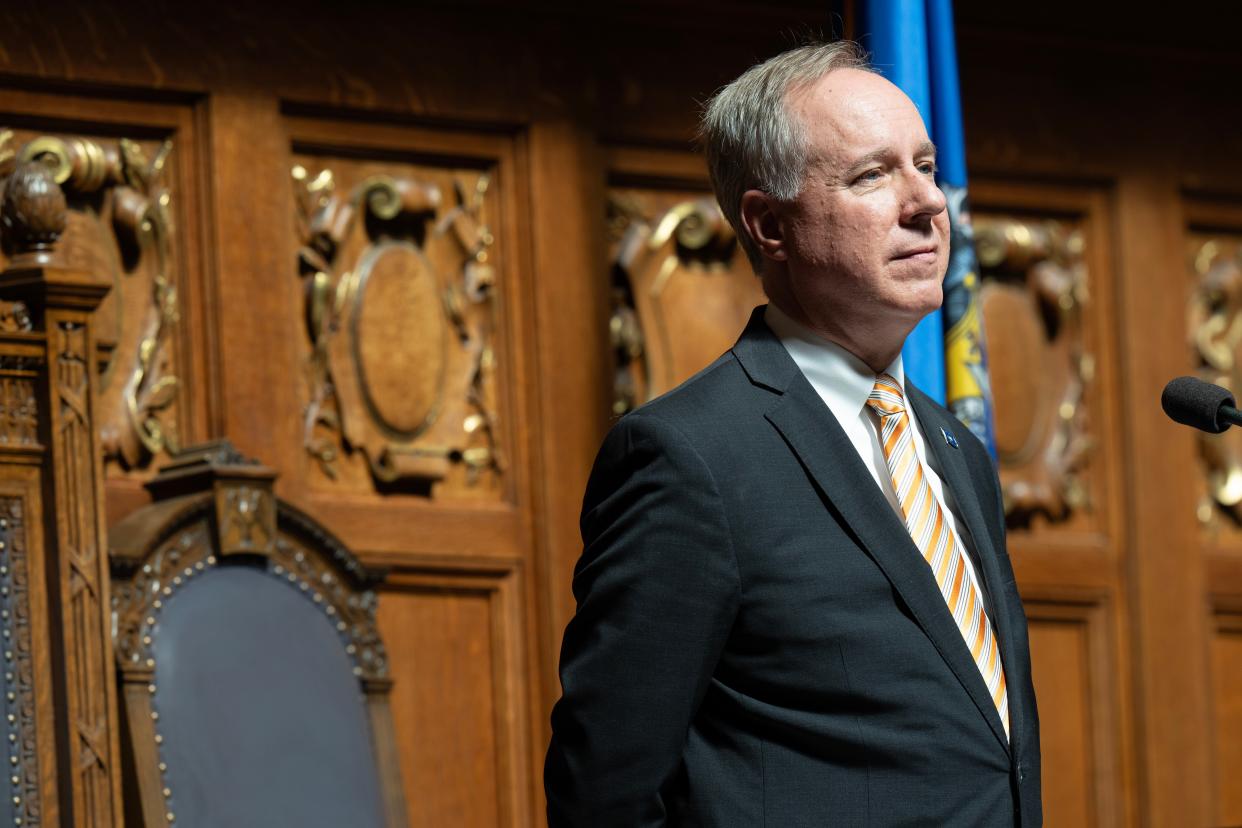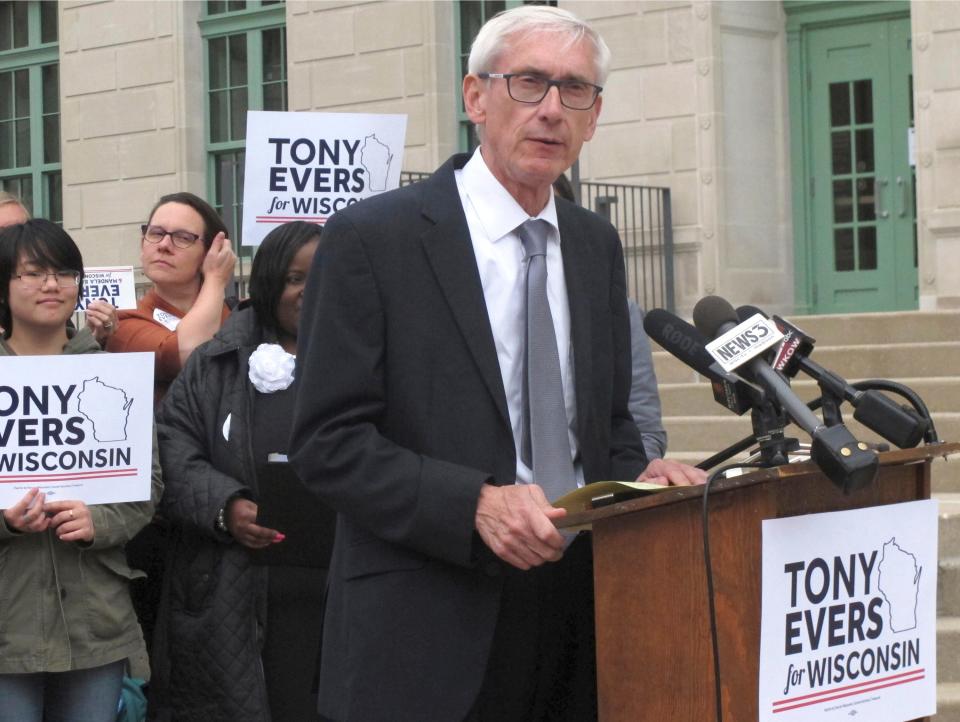Republicans' redistricting plan is nearly identical to Democrats' bill from 4 past sessions

- Oops!Something went wrong.Please try again later.
MADISON – A new Republican nonpartisan redistricting plan closely mirrors a bill introduced in four previous legislative sessions by Democrats who now oppose the same ideas.
Both parties have swapped positions on the legislation as they battle for power in the Legislature.
Republicans now prefer nonpartisan redistricting as the state Supreme Court's new liberal majority is poised to take up lawsuits aimed at the state's electoral maps.
And Democrats, who stand to benefit from a potential redistricting ruling from the court, now reject the nonpartisan system they have long advocated.
The GOP plan is nearly identical to what Democrats have proposed as early as 2003: transferring map-drawing authority to the nonpartisan Legislative Reference Bureau.
But beginning in 2019, Democrats added to their bill a three-fourths vote requirement to pass a third set of maps, based on concerns from fair maps advocates that Republicans could manipulate the process. Republicans left that threshold out of their current plan.
Democrats' bills would have also changed the process for congressional maps, unlike Republicans' current proposal that addresses only legislative maps.
More: Why Wisconsin Republicans suddenly embraced redistricting changes and Democrats want no part of it
Here's an overview of where the GOP's plan currently stands and how it compares to past versions introduced by Democrats and Gov. Tony Evers.
What was the redistricting plan Assembly Republicans passed?
The Assembly passed Republicans' redistricting plan Sept. 14 but not before amending the bill language in attempts to shore up support among Democrats.
The proposal would turn map-drawing authority over to the Legislative Reference Bureau, a nonpartisan agency that drafts bills for lawmakers. LRB would report to a five-member commission, which would consist of two Republicans, two Democrats and a fifth chairperson chosen by the four partisans.
The agency would then submit maps to the Legislature, which could reject the first two proposals. Lawmakers could amend, or change, the third proposal with a simple majority vote — which involves at least half of members voting for it.
The maps would then require the governor’s approval and would likely end up in the courts without an agreement — unless the Legislature successfully overrides the governor’s veto.
Republicans offered seven amendments in attempts to shore up support among Democrats. Rep. LaKeshia Myers was the only Democrat to vote for the final version. Two other Milwaukee Democrats, Reps. Marisabel Cabrera and Sylvia Ortiz-Velez, voted for some of the following changes currently in the bill:
The Reference Bureau would provide assistance to the five-member commission about its operations.
The majority vote to pass the third set of maps must be bipartisan — at least one member from each party.
The commission would be prevented from deadlocking on votes.
The commission must appoint someone with expertise in the Voting Rights Act to give advice on complying with the federal law.
The Legislature could make changes to the maps only to correct language. Initially, the bill would have allowed any amendment on the third set of maps, or further rounds.
A public hearing on the maps must be held in Milwaukee, in addition to Madison and northern Wisconsin.
The drafting file must be available for the public to view.
How does the plan compare to past proposals introduced by Democrats?
Republicans' plan closely mirrors a bill that Democrats have introduced in 2003, 2013, 2015 and 2017, though those proposals would have also applied to congressional maps, not just legislative districts.
There are a few differences in the bill language, including how the LRB would address the boundaries of political subdivisions, make the population size of Assembly and Senate districts roughly equal and ensure the right to vote for racial and language minority groups.
But the main idea — tasking the LRB with drawing maps in a nonpartisan way — has remained the same.
In 2009, a Democrat also proposed turning redistricting over to the LRB, and in 2011, Democrats — including two current senators — suggested the now-defunct Government Accountability Board join LRB to undertake redistricting. Those bills set up a process for three rounds of map proposals but did not clarify vote thresholds or procedures if the maps went to a fourth round.
In 2019 and 2021, the bill had a major modification: in order to pass the third set of maps, and any amendments to them, three-fourths of all members in both the Assembly and Senate had to vote for them.
That provision is not included in the new plan introduced by six Republicans, though five in that group co-sponsored the version with the three-fourths vote requirement in the past. Rep. Todd Novak, R-Dodgeville, was the first Republican to join the bill in 2015 and supported it each session thereafter.
Other changes in the 2019 and 2021 bills include a three-fourths vote by the commission to hire outside experts, holding hearings on the maps in each congressional district and requiring that draft materials be available online. Republicans have since addressed that last point through an amendment.
None of the proposals over the past 20 years received public hearings. Democrats also authored resolutions to change the redistricting process, including constitutional amendments that would ask voters to weigh in on the proposal that included the three-fourths vote. Some proposed a separate commission or panel other than the LRB: in 2007, a handful of Democrats suggested creating a redistricting board that would include state offices like the attorney general and secretary of state.
Democrats, and a few Republican co-sponsors, had not reintroduced their proposal this year prior to the surprise announcement by Speaker Robin Vos, R-Rochester, and Assembly Republicans. Minority Leader Greta Neubauer, D-Racine, said Democrats will again introduce their own redistricting bill and are "looking to other states, other models and making sure that we're doing everything we can here to create a process that works for Wisconsin."
How does the plan compare to Gov. Tony Evers' past budget proposals?

Evers has proposed nonpartisan redistricting in his first two biennial budget requests, though Republicans often begin their version of the state budget by removing hundreds of his policy priorities.
In response to the current plan, Evers criticized having someone "Legislature-picked and Legislature-approved draw Wisconsin’s maps" — referring to Republicans choosing the LRB.
"This is an issue that I ran on, it’s a promise I made to the people of our state, and I’m optimistic that we will not only finally secure fair maps but that I will have the opportunity to enact legislation creating a nonpartisan redistricting commission in Wisconsin before my time as governor comes to an end," Evers said in a statement.
But in 2019, Evers proposed using the same agency to redraw legislative and congressional maps. He requested $10,000 for LRB every two years for that purpose. He also recommended creating a commission to oversee the process.
His 2021 proposal was different. It would have required the Legislature to adopt maps drawn by his own redistricting commission made up of citizens from each congressional district chosen by a panel of three retired judges. Ultimately, Republicans ignored the commission's work and Evers did not submit their maps when redistricting landed in court.
Evers did not include provisions to implement nonpartisan redistricting in his third, 2023-25 budget proposal.
In their bill, Republicans introduced a new provision that was not included in any previous version of the bill: if the LRB re-draws a second or third set of maps, the agency must take into account the reasons the governor vetoed them, if applicable, in addition to the Legislature's concerns.
What's next for the redistricting proposal?
Though the Republican plan passed the Assembly, it still needs to go through the Senate before reaching the governor. One of the bill authors said the Senate will hold the first public hearing on the Republican proposal, where lawmakers and advocates would likely debate the finer details.
But Senate Majority Leader Devin LeMahieu, R-Oostburg, has not yet committed to scheduling a full Senate vote. Even if the Senate passes it, Evers is all but certain to veto it.
THANK YOU: Subscribers' support makes this work possible. Help us share the knowledge by buying a gift subscription.
DOWNLOAD THE APP: Get the latest news, sports and more
This article originally appeared on Milwaukee Journal Sentinel: How GOP redistricting legislation compares with Democrats' proposals

